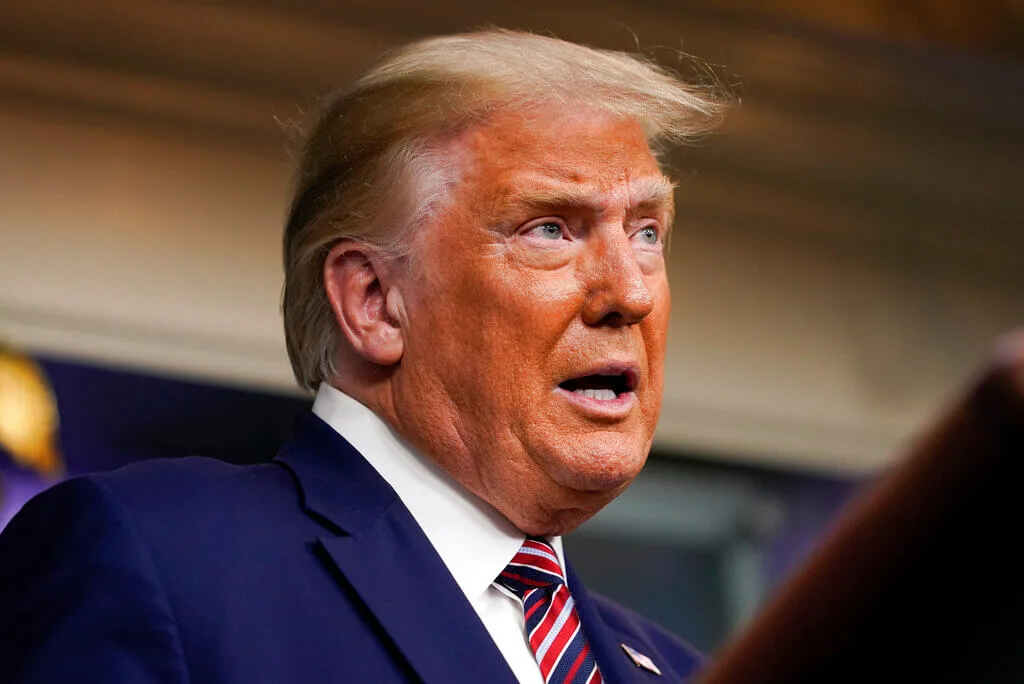
President Donald Trump speaking during a news conference at the White House, Sunday, Sept. 27, 2020, in Washington. (AP Photo/Carolyn Kaster)
The president only paid $750 in federal income taxes in 2016 and 2017. But that’s only one element of what the documents reveal.
The year he was elected president, Donald Trump paid only $750 in federal income taxes, far less than most Americans, according to a bombshell New York Times report published Sunday.
Trump paid that same amount in 2017, his first year in the White House, and paid no income tax at all in 10 of the previous 15 years, primarily because the self-proclaimed billionaire reported losing much more money than he made.
In total, the Times received more than two decades of tax-return data for Trump and the more than 500 entities that make up The Trump Organization.
Here are the biggest takeaways from the Times’ report:
Trump Paid Substantially Less in Taxes Than Most Americans
Trump paid only $750 in taxes in 2016 and 2017 and paid no federal income taxes in 11 of the 18 years the Times analyzed—a luxury not available to most Americans.
Democratic nominee Joe Biden’s campaign quickly pointed out in an ad that Trump paid far less in income taxes than the following average Americans, based on 2019 data:
- elementary school teacher ($7,239)
- firefighter ($5,283)
- construction manager ($16,447)
- registered nurse ($10,216)
Trump also paid less than those Americans earning under $5,000 per year, according to Lily Batchelder, a professor of taxation at the New York University School of Law.
The Times report also found that in some cases, Trump and his companies paid more taxes to foreign governments than the US government. Trump or his companies paid $156,824 in taxes to the Philippines in 2017, $145,400 to India, and $15,598 to Panama. Reporters and activists also pointed out that Trump paid less in taxes than the average undocumented immigrant he has repeatedly demonized.
Trump Used Shady Deductions and Refunds To Cut His Tax Bill
Trump was able to reduce his tax bill through questionable efforts, including applying for and receiving a nearly $73 million tax refund in 2010 that is currently being audited by the IRS. If the agency finds that Trump’s refund was illegitimately obtained, he could be on the hook for more than $100 million.
Trump also reduced his taxes by using deductions and classifying what may have been personal expenses as the cost of doing business. He included his residences, golf courses, and the airplane he uses to travel between them as business expenses. According to the Times, he also categorized more than $70,000 in hairstyling costs during “The Apprentice” as a business expense, as well as another $100,000 paid to Ivanka Trump’s favorite hair and makeup artist.
Sorting Fact From Fiction: Sign Up for COURIER’s newsletter.
Many of Trump’s businesses also reported losing tens of millions of dollars, which allowed him to lower his tax bill. Trump’s tax records showed that in 2018, he lost $47 million, and that most of his businesses, including golf courses and hotels, reported losing millions of dollars each year. Since 2000, Trump has reported losing more than $315 million at his golf courses.
Trump’s business losses were so large that they largely erased the $427 million Trump earned from “The Apprentice” and licensing and endorsement deals that came with his growing fame. But years of losses required Trump to take on hundreds of millions of dollars in loans, which are coming due soon.
Trump Owes People A Lot of Money
Trump’s loans and debts appear to total a whopping $421 million—all of which he has personally guaranteed—with more than $300 million in loans coming due over the next four years. The balances on those loans had not been paid down by the end of 2018, according to the Times.
Trump’s Doral golf resort ($125 million) and Washington hotel ($160 million), both of which are struggling, are responsible for the bulk of the debt. Trump also still owes the full $100 million principle for a mortgage he took out on the commercial space in Trump Tower in 2012. That loan comes due in 2022.
Should Trump win re-election, it raises the possibility that his lenders could have to decide whether to foreclose on a sitting president.
These debts also raise a key question: Who are his lenders?
The answer: We don’t know.
Tax returns often do not identify lenders, and that is the case in the returns obtained by the Times. The mystery surrounding Trump’s lenders raises legitimate public policy and national security concerns. If Trump owes a domestic or foreign lender hundreds of millions of dollars, it could give them an incredible amount of leverage over a sitting president.
“The potentially destructive power of that sort of hold on a President of the United States is beyond comprehension,” David Atkins noted in the Washington Monthly. “Imagine if a president owed millions to the mob or to those with close ties to a foreign government, and those individuals both controlled the president’s financial future and knew of corrupt criminal activity. The president might act with otherwise strange deference to said mobsters and those connected to them, and bend public policy on their behalf. If they were tied to fossil fuel interests, the president might set the globe on fire rather than cross them. If his creditors were simply a wealthy set of Wall Street tycoons, he might rig all financial policy on their direct behalf.”
Why This All Matters to the Presidency and 2020 Presidential Campaign
Beyond the potential power his lenders might hold over him, Trump’s avoidance of federal income tax has also deprived the US government of funds that could go towards education, healthcare, and economic programs that benefit everyday Americans.
They also give credence to the argument made by lawmakers like Sen. Bernie Sanders of Vermont that wealthy Americans like Trump play by a different set of rules.
“Trump’s tax returns tell us that he’s either a very bad businessman or a tax cheat—likely both. But more importantly, it shows how the wealthy, unlike most Americans, are able to avoid paying taxes,” Sanders said in a tweet on Monday. “The top 1% is responsible for 70% of unpaid taxes. It’s time to tax the rich.”
Joe Biden, the Democratic nominee, has released a proposal that will take steps to do that. Biden’s plan would:
- Increase the tax rate on the highest income earners (about $510,000 or more) from 37% to nearly 40%.
- Cap some deductions for the wealthiest Americans, meaning potential tax increases for some individuals or families who make $400,000 or more.
- Prevent companies like Amazon from avoiding tax payments altogether by establishing a minimum 15% tax on corporate profits.
- Make the wealthiest Americans pay their fair share in Social Security taxes. Right now, any income above $137,000 isn’t taxed for Social Security. Biden’s plan would restart the tax on any income above $400,001. It would also close that gap over time, so everyone is paying a portion of their full salary into Social Security, regardless of how much money they make.
- Right now, earnings from investments are taxed at only about half as much as regular income, disproportionately benefiting wealthy Americans (only 22% of Americans making less than $40,000 per year own stock). Biden would tax investments like real estate and stock over $1 million at the same rate as regular income.
Politics

Emergency rooms refused to treat pregnant women, leaving one to miscarry in a lobby restroom
By AMANDA SEITZ Associated Press WASHINGTON (AP) — One woman miscarried in the lobby restroom of a Texas emergency room as front desk staff refused...



Video: These are Florida’s best theme parks, according to top US 2024 guide
Local News



Emergency rooms refused to treat pregnant women, leaving one to miscarry in a lobby restroom
By AMANDA SEITZ Associated Press WASHINGTON (AP) — One woman miscarried in the lobby restroom of a Texas emergency room as front desk staff refused...







